Project Quality Management Plan: Controls, Standards, and Legal Issues
VerifiedAdded on 2020/02/18
|16
|3136
|46
Report
AI Summary
This report provides a comprehensive overview of project quality management, detailing the essential controls and standards necessary for successful project execution. It begins by defining quality and outlining the components of a quality management plan, including deliverables, customer satisfaction, and process quality. The report then explores various quality control tools and techniques, such as cause-and-effect diagrams, control charts, and inspections, to ensure project deliverables meet defined standards. Furthermore, it argues for the importance of cultural awareness, training, and addressing legal issues in project management, examining how cultural awareness impacts both the human and process aspects of change management. The report also delves into IT project management legal issues, including project terms, outsourcing, and risk insurance, while addressing ethical cultural differences in global teams. By examining these critical aspects, the report provides a robust framework for effective project quality management.
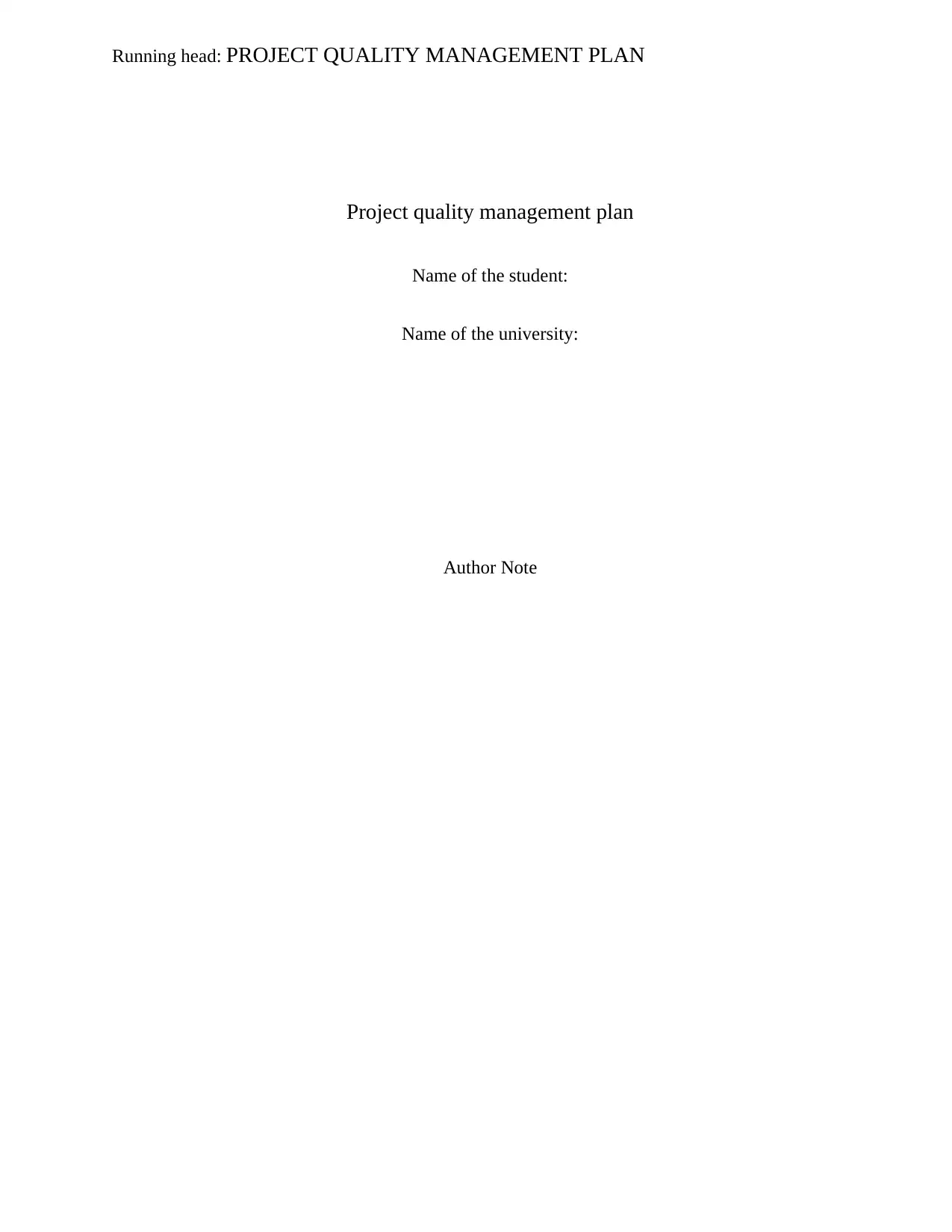
Running head: PROJECT QUALITY MANAGEMENT PLAN
Project quality management plan
Name of the student:
Name of the university:
Author Note
Project quality management plan
Name of the student:
Name of the university:
Author Note
Paraphrase This Document
Need a fresh take? Get an instant paraphrase of this document with our AI Paraphraser
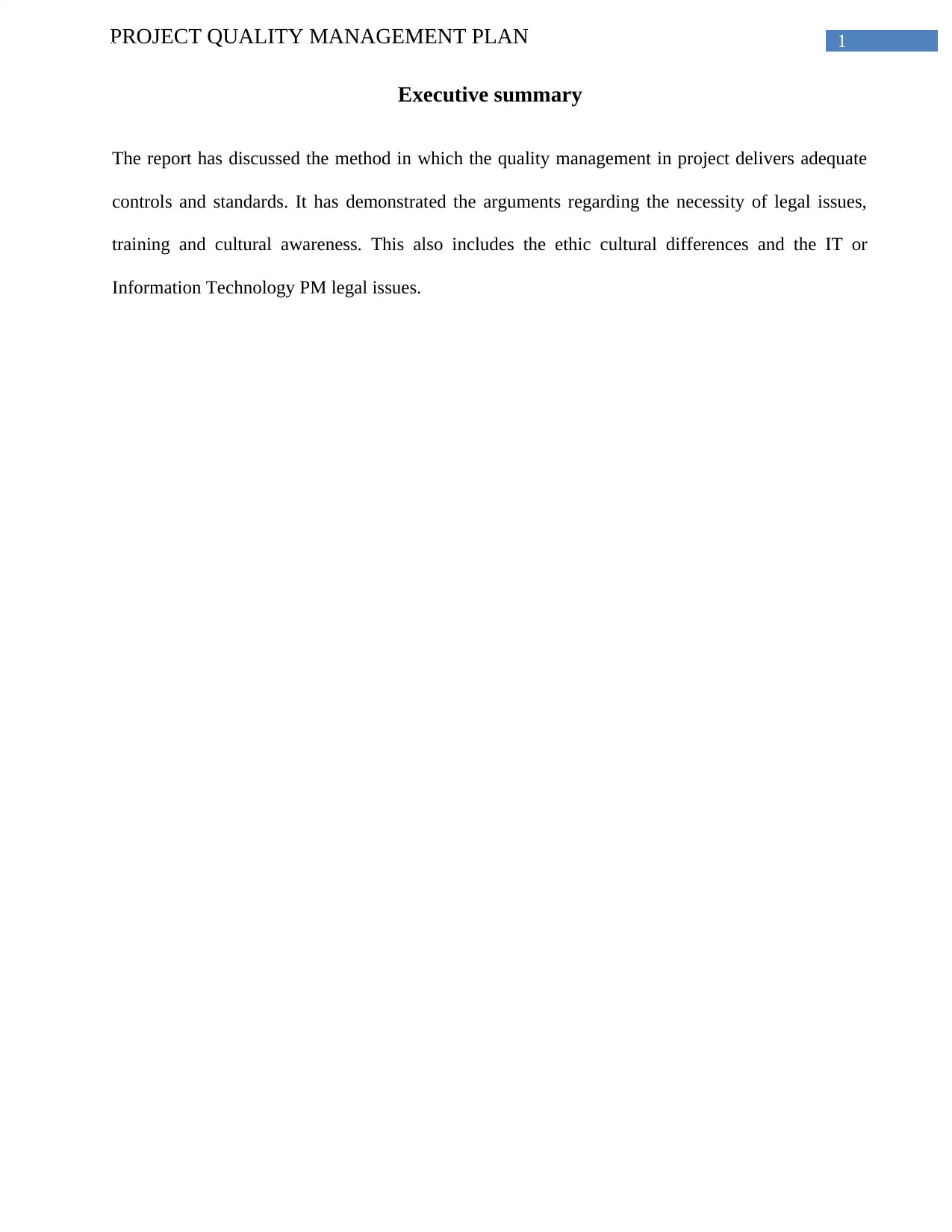
1PROJECT QUALITY MANAGEMENT PLAN
Executive summary
The report has discussed the method in which the quality management in project delivers adequate
controls and standards. It has demonstrated the arguments regarding the necessity of legal issues,
training and cultural awareness. This also includes the ethic cultural differences and the IT or
Information Technology PM legal issues.
Executive summary
The report has discussed the method in which the quality management in project delivers adequate
controls and standards. It has demonstrated the arguments regarding the necessity of legal issues,
training and cultural awareness. This also includes the ethic cultural differences and the IT or
Information Technology PM legal issues.
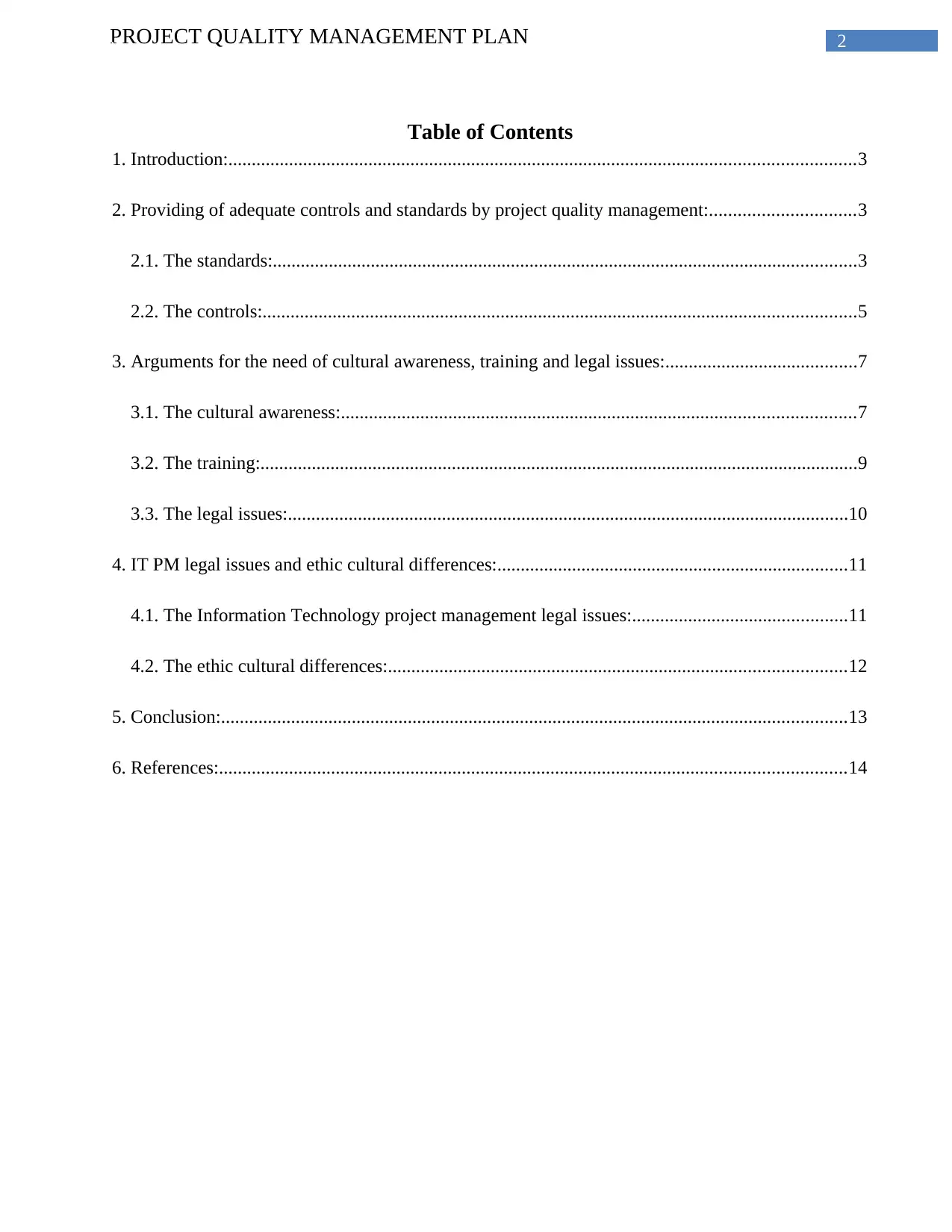
2PROJECT QUALITY MANAGEMENT PLAN
Table of Contents
1. Introduction:......................................................................................................................................3
2. Providing of adequate controls and standards by project quality management:...............................3
2.1. The standards:.............................................................................................................................3
2.2. The controls:...............................................................................................................................5
3. Arguments for the need of cultural awareness, training and legal issues:.........................................7
3.1. The cultural awareness:..............................................................................................................7
3.2. The training:................................................................................................................................9
3.3. The legal issues:........................................................................................................................10
4. IT PM legal issues and ethic cultural differences:...........................................................................11
4.1. The Information Technology project management legal issues:..............................................11
4.2. The ethic cultural differences:..................................................................................................12
5. Conclusion:......................................................................................................................................13
6. References:......................................................................................................................................14
Table of Contents
1. Introduction:......................................................................................................................................3
2. Providing of adequate controls and standards by project quality management:...............................3
2.1. The standards:.............................................................................................................................3
2.2. The controls:...............................................................................................................................5
3. Arguments for the need of cultural awareness, training and legal issues:.........................................7
3.1. The cultural awareness:..............................................................................................................7
3.2. The training:................................................................................................................................9
3.3. The legal issues:........................................................................................................................10
4. IT PM legal issues and ethic cultural differences:...........................................................................11
4.1. The Information Technology project management legal issues:..............................................11
4.2. The ethic cultural differences:..................................................................................................12
5. Conclusion:......................................................................................................................................13
6. References:......................................................................................................................................14
⊘ This is a preview!⊘
Do you want full access?
Subscribe today to unlock all pages.

Trusted by 1+ million students worldwide
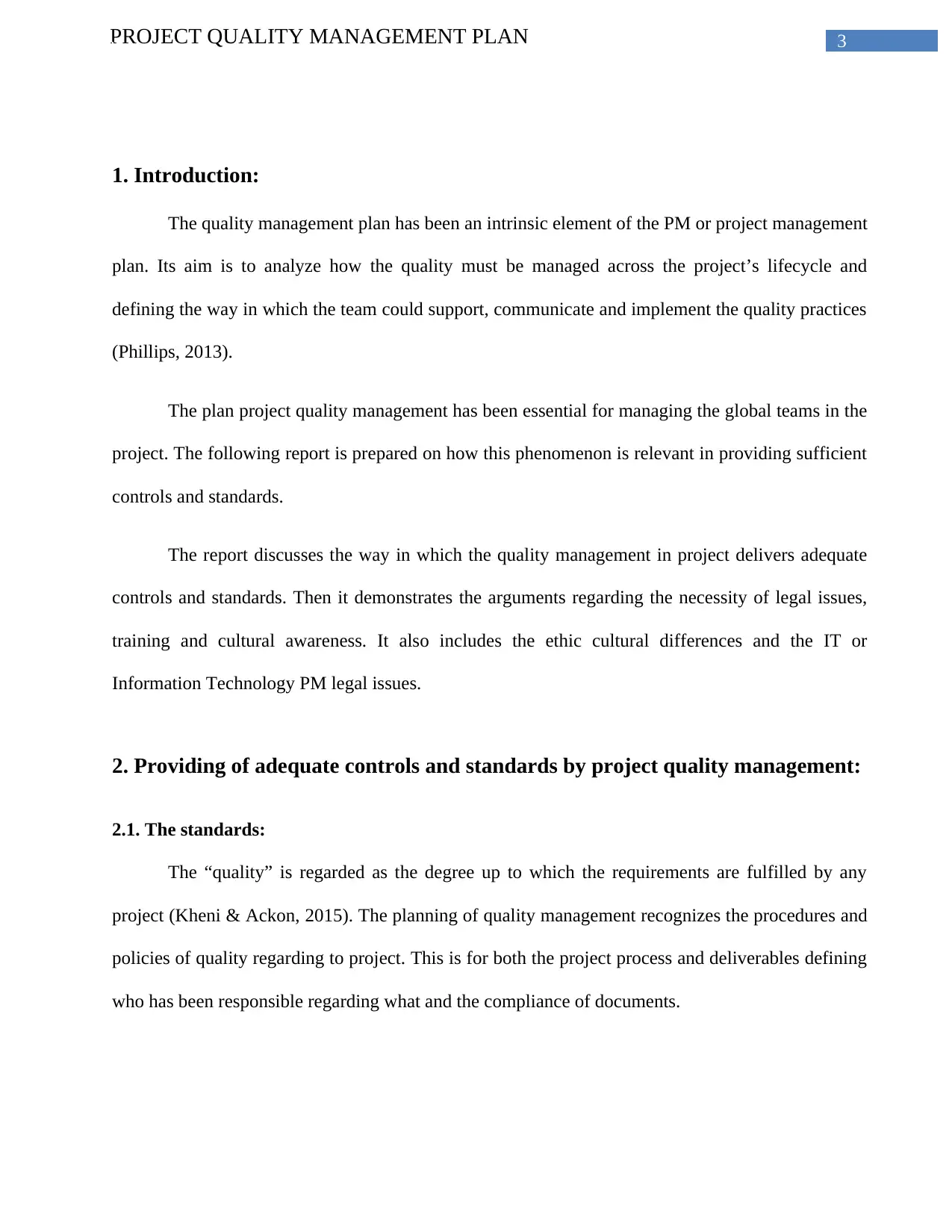
3PROJECT QUALITY MANAGEMENT PLAN
1. Introduction:
The quality management plan has been an intrinsic element of the PM or project management
plan. Its aim is to analyze how the quality must be managed across the project’s lifecycle and
defining the way in which the team could support, communicate and implement the quality practices
(Phillips, 2013).
The plan project quality management has been essential for managing the global teams in the
project. The following report is prepared on how this phenomenon is relevant in providing sufficient
controls and standards.
The report discusses the way in which the quality management in project delivers adequate
controls and standards. Then it demonstrates the arguments regarding the necessity of legal issues,
training and cultural awareness. It also includes the ethic cultural differences and the IT or
Information Technology PM legal issues.
2. Providing of adequate controls and standards by project quality management:
2.1. The standards:
The “quality” is regarded as the degree up to which the requirements are fulfilled by any
project (Kheni & Ackon, 2015). The planning of quality management recognizes the procedures and
policies of quality regarding to project. This is for both the project process and deliverables defining
who has been responsible regarding what and the compliance of documents.
1. Introduction:
The quality management plan has been an intrinsic element of the PM or project management
plan. Its aim is to analyze how the quality must be managed across the project’s lifecycle and
defining the way in which the team could support, communicate and implement the quality practices
(Phillips, 2013).
The plan project quality management has been essential for managing the global teams in the
project. The following report is prepared on how this phenomenon is relevant in providing sufficient
controls and standards.
The report discusses the way in which the quality management in project delivers adequate
controls and standards. Then it demonstrates the arguments regarding the necessity of legal issues,
training and cultural awareness. It also includes the ethic cultural differences and the IT or
Information Technology PM legal issues.
2. Providing of adequate controls and standards by project quality management:
2.1. The standards:
The “quality” is regarded as the degree up to which the requirements are fulfilled by any
project (Kheni & Ackon, 2015). The planning of quality management recognizes the procedures and
policies of quality regarding to project. This is for both the project process and deliverables defining
who has been responsible regarding what and the compliance of documents.
Paraphrase This Document
Need a fresh take? Get an instant paraphrase of this document with our AI Paraphraser
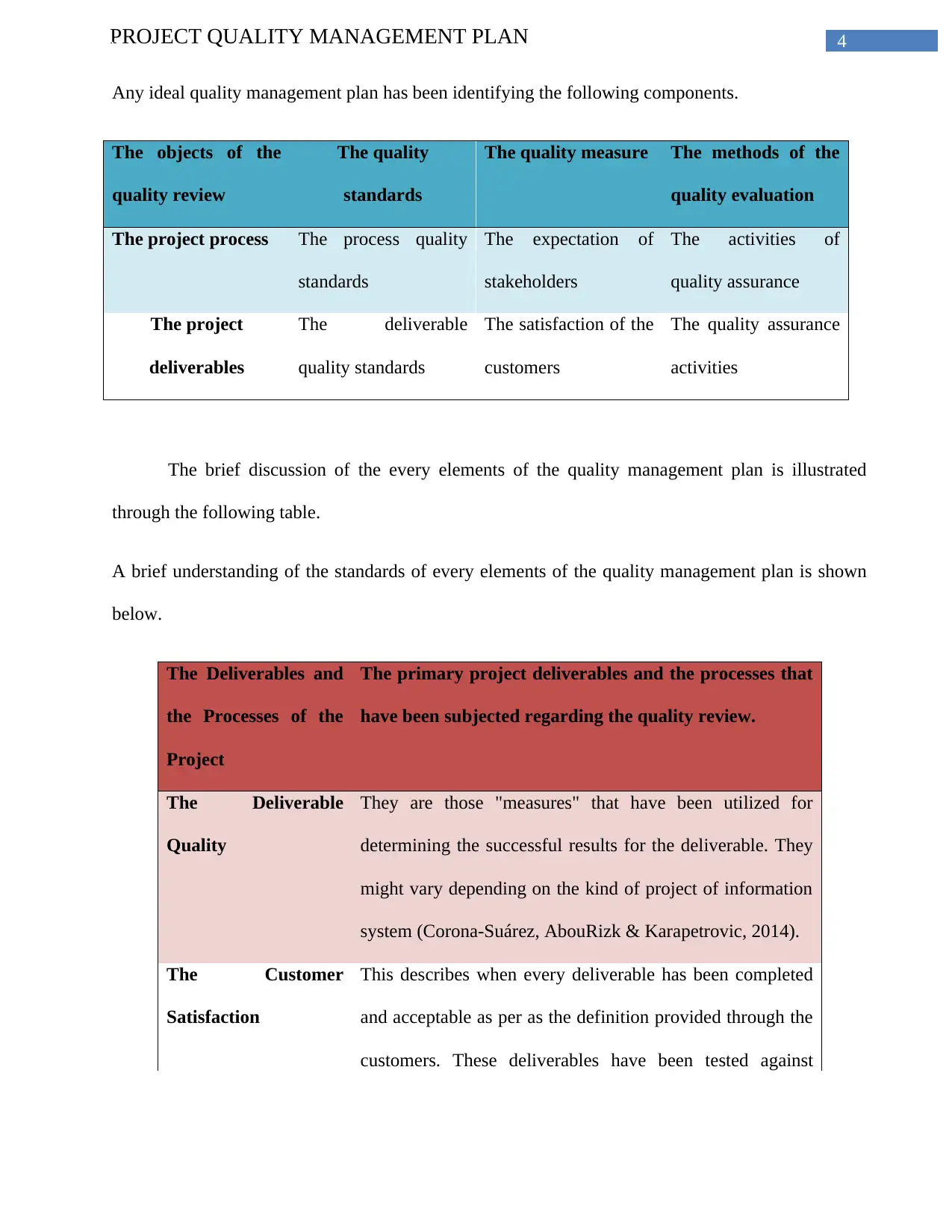
4PROJECT QUALITY MANAGEMENT PLAN
Any ideal quality management plan has been identifying the following components.
The objects of the
quality review
The quality
standards
The quality measure The methods of the
quality evaluation
The project process The process quality
standards
The expectation of
stakeholders
The activities of
quality assurance
The project
deliverables
The deliverable
quality standards
The satisfaction of the
customers
The quality assurance
activities
The brief discussion of the every elements of the quality management plan is illustrated
through the following table.
A brief understanding of the standards of every elements of the quality management plan is shown
below.
The Deliverables and
the Processes of the
Project
The primary project deliverables and the processes that
have been subjected regarding the quality review.
The Deliverable
Quality
They are those "measures" that have been utilized for
determining the successful results for the deliverable. They
might vary depending on the kind of project of information
system (Corona-Suárez, AbouRizk & Karapetrovic, 2014).
The Customer
Satisfaction
This describes when every deliverable has been completed
and acceptable as per as the definition provided through the
customers. These deliverables have been tested against
Any ideal quality management plan has been identifying the following components.
The objects of the
quality review
The quality
standards
The quality measure The methods of the
quality evaluation
The project process The process quality
standards
The expectation of
stakeholders
The activities of
quality assurance
The project
deliverables
The deliverable
quality standards
The satisfaction of the
customers
The quality assurance
activities
The brief discussion of the every elements of the quality management plan is illustrated
through the following table.
A brief understanding of the standards of every elements of the quality management plan is shown
below.
The Deliverables and
the Processes of the
Project
The primary project deliverables and the processes that
have been subjected regarding the quality review.
The Deliverable
Quality
They are those "measures" that have been utilized for
determining the successful results for the deliverable. They
might vary depending on the kind of project of information
system (Corona-Suárez, AbouRizk & Karapetrovic, 2014).
The Customer
Satisfaction
This describes when every deliverable has been completed
and acceptable as per as the definition provided through the
customers. These deliverables have been tested against
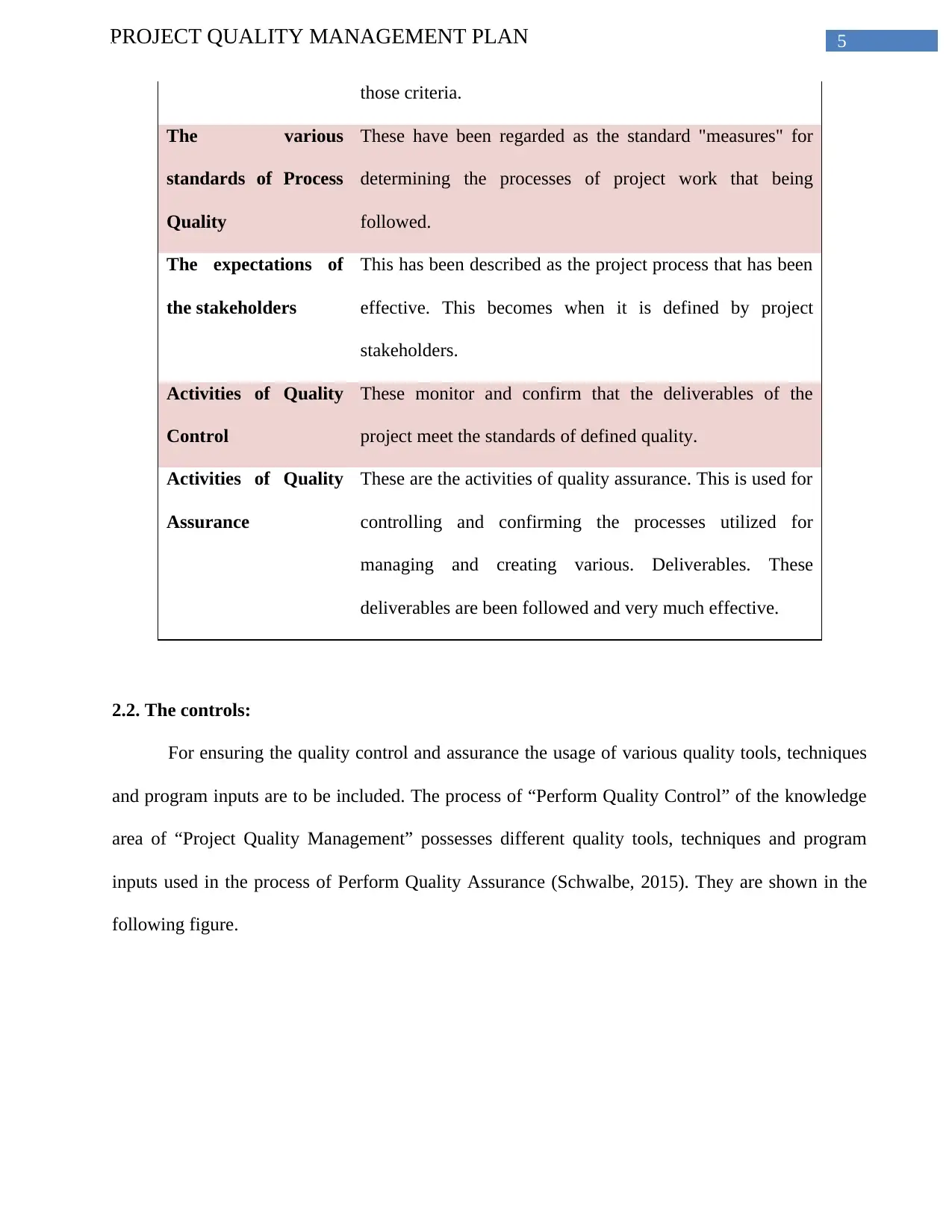
5PROJECT QUALITY MANAGEMENT PLAN
those criteria.
The various
standards of Process
Quality
These have been regarded as the standard "measures" for
determining the processes of project work that being
followed.
The expectations of
the stakeholders
This has been described as the project process that has been
effective. This becomes when it is defined by project
stakeholders.
Activities of Quality
Control
These monitor and confirm that the deliverables of the
project meet the standards of defined quality.
Activities of Quality
Assurance
These are the activities of quality assurance. This is used for
controlling and confirming the processes utilized for
managing and creating various. Deliverables. These
deliverables are been followed and very much effective.
2.2. The controls:
For ensuring the quality control and assurance the usage of various quality tools, techniques
and program inputs are to be included. The process of “Perform Quality Control” of the knowledge
area of “Project Quality Management” possesses different quality tools, techniques and program
inputs used in the process of Perform Quality Assurance (Schwalbe, 2015). They are shown in the
following figure.
those criteria.
The various
standards of Process
Quality
These have been regarded as the standard "measures" for
determining the processes of project work that being
followed.
The expectations of
the stakeholders
This has been described as the project process that has been
effective. This becomes when it is defined by project
stakeholders.
Activities of Quality
Control
These monitor and confirm that the deliverables of the
project meet the standards of defined quality.
Activities of Quality
Assurance
These are the activities of quality assurance. This is used for
controlling and confirming the processes utilized for
managing and creating various. Deliverables. These
deliverables are been followed and very much effective.
2.2. The controls:
For ensuring the quality control and assurance the usage of various quality tools, techniques
and program inputs are to be included. The process of “Perform Quality Control” of the knowledge
area of “Project Quality Management” possesses different quality tools, techniques and program
inputs used in the process of Perform Quality Assurance (Schwalbe, 2015). They are shown in the
following figure.
⊘ This is a preview!⊘
Do you want full access?
Subscribe today to unlock all pages.

Trusted by 1+ million students worldwide
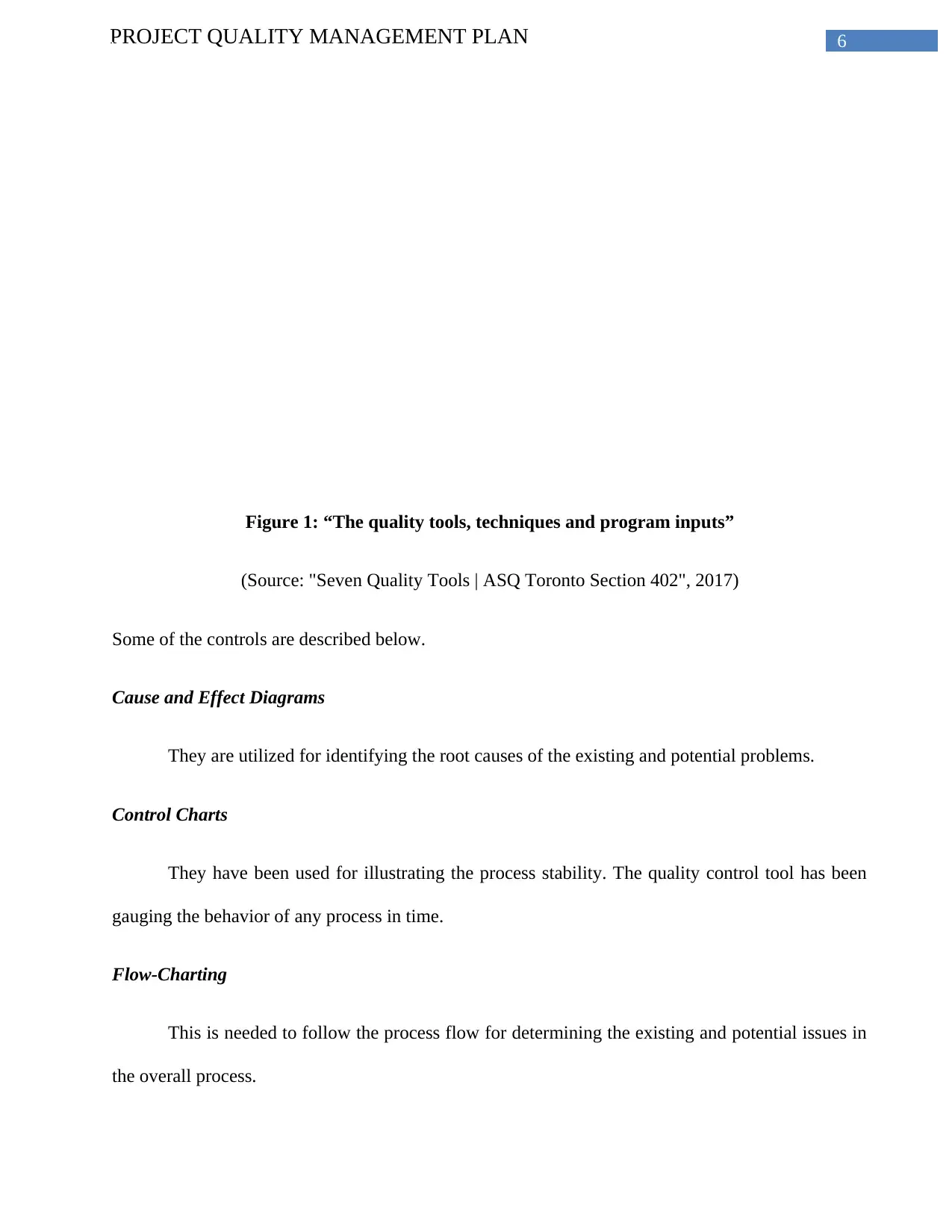
6PROJECT QUALITY MANAGEMENT PLAN
Figure 1: “The quality tools, techniques and program inputs”
(Source: "Seven Quality Tools | ASQ Toronto Section 402", 2017)
Some of the controls are described below.
Cause and Effect Diagrams
They are utilized for identifying the root causes of the existing and potential problems.
Control Charts
They have been used for illustrating the process stability. The quality control tool has been
gauging the behavior of any process in time.
Flow-Charting
This is needed to follow the process flow for determining the existing and potential issues in
the overall process.
Thevariouscontrols
Figure 1: “The quality tools, techniques and program inputs”
(Source: "Seven Quality Tools | ASQ Toronto Section 402", 2017)
Some of the controls are described below.
Cause and Effect Diagrams
They are utilized for identifying the root causes of the existing and potential problems.
Control Charts
They have been used for illustrating the process stability. The quality control tool has been
gauging the behavior of any process in time.
Flow-Charting
This is needed to follow the process flow for determining the existing and potential issues in
the overall process.
Thevariouscontrols
Paraphrase This Document
Need a fresh take? Get an instant paraphrase of this document with our AI Paraphraser
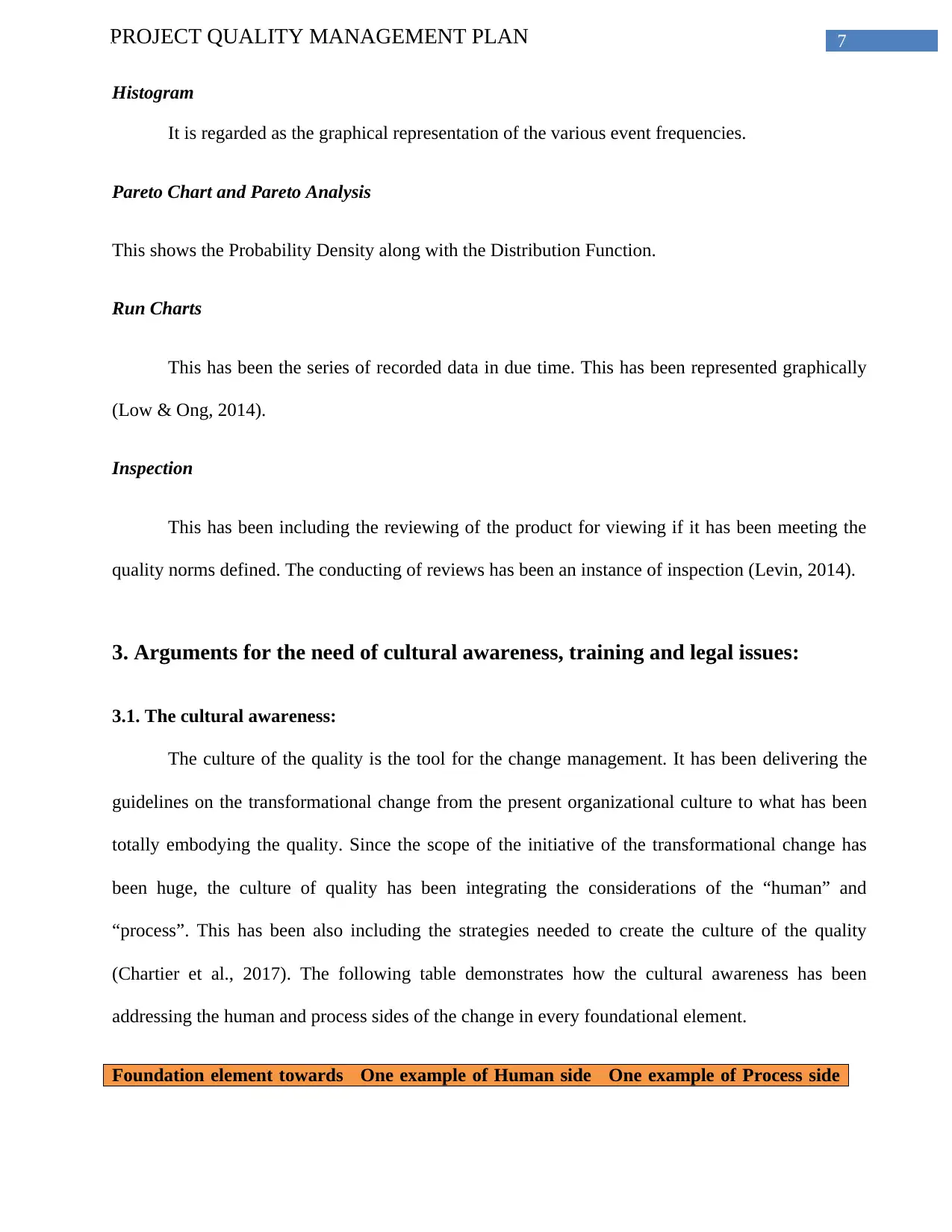
7PROJECT QUALITY MANAGEMENT PLAN
Histogram
It is regarded as the graphical representation of the various event frequencies.
Pareto Chart and Pareto Analysis
This shows the Probability Density along with the Distribution Function.
Run Charts
This has been the series of recorded data in due time. This has been represented graphically
(Low & Ong, 2014).
Inspection
This has been including the reviewing of the product for viewing if it has been meeting the
quality norms defined. The conducting of reviews has been an instance of inspection (Levin, 2014).
3. Arguments for the need of cultural awareness, training and legal issues:
3.1. The cultural awareness:
The culture of the quality is the tool for the change management. It has been delivering the
guidelines on the transformational change from the present organizational culture to what has been
totally embodying the quality. Since the scope of the initiative of the transformational change has
been huge, the culture of quality has been integrating the considerations of the “human” and
“process”. This has been also including the strategies needed to create the culture of the quality
(Chartier et al., 2017). The following table demonstrates how the cultural awareness has been
addressing the human and process sides of the change in every foundational element.
Foundation element towards One example of Human side One example of Process side
Histogram
It is regarded as the graphical representation of the various event frequencies.
Pareto Chart and Pareto Analysis
This shows the Probability Density along with the Distribution Function.
Run Charts
This has been the series of recorded data in due time. This has been represented graphically
(Low & Ong, 2014).
Inspection
This has been including the reviewing of the product for viewing if it has been meeting the
quality norms defined. The conducting of reviews has been an instance of inspection (Levin, 2014).
3. Arguments for the need of cultural awareness, training and legal issues:
3.1. The cultural awareness:
The culture of the quality is the tool for the change management. It has been delivering the
guidelines on the transformational change from the present organizational culture to what has been
totally embodying the quality. Since the scope of the initiative of the transformational change has
been huge, the culture of quality has been integrating the considerations of the “human” and
“process”. This has been also including the strategies needed to create the culture of the quality
(Chartier et al., 2017). The following table demonstrates how the cultural awareness has been
addressing the human and process sides of the change in every foundational element.
Foundation element towards One example of Human side One example of Process side
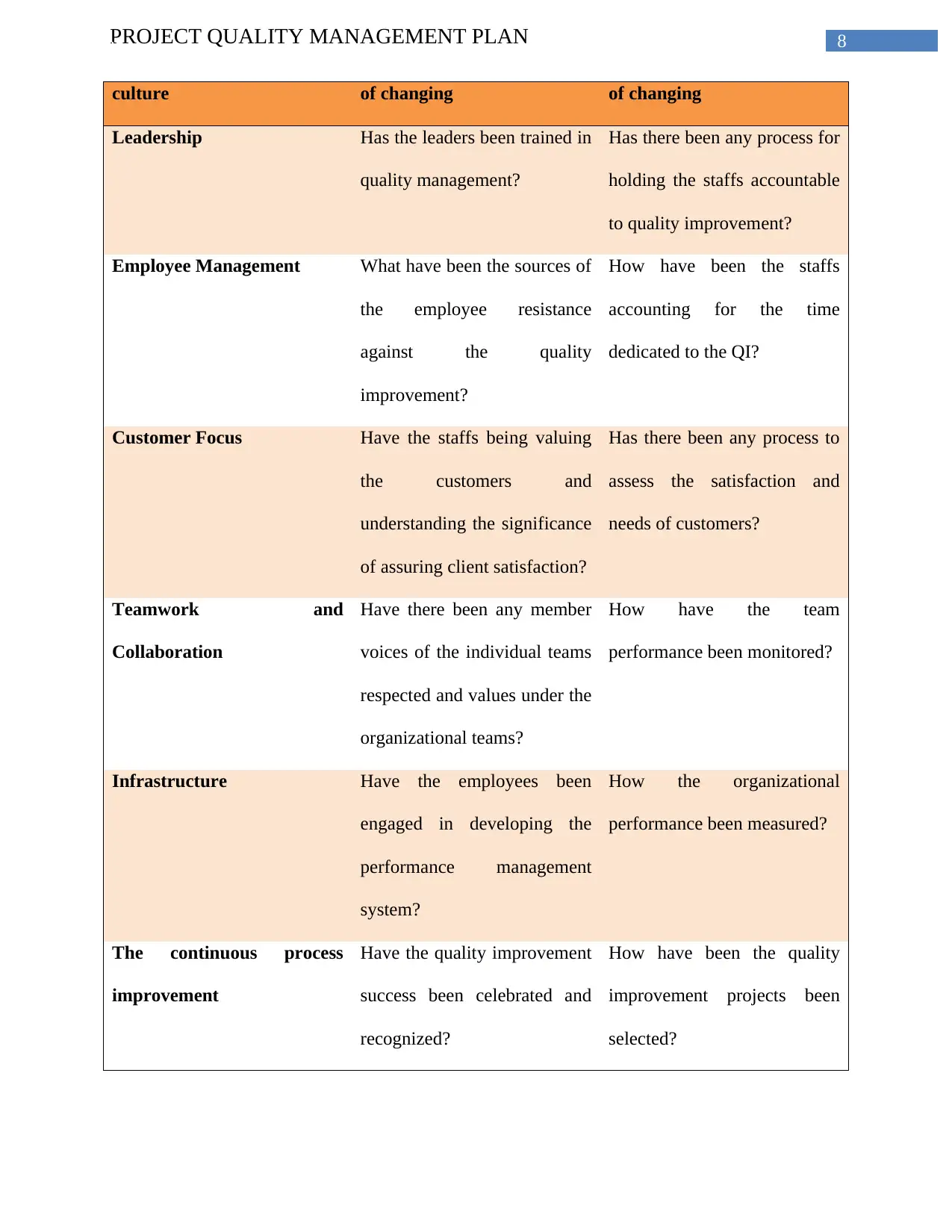
8PROJECT QUALITY MANAGEMENT PLAN
culture of changing of changing
Leadership Has the leaders been trained in
quality management?
Has there been any process for
holding the staffs accountable
to quality improvement?
Employee Management What have been the sources of
the employee resistance
against the quality
improvement?
How have been the staffs
accounting for the time
dedicated to the QI?
Customer Focus Have the staffs being valuing
the customers and
understanding the significance
of assuring client satisfaction?
Has there been any process to
assess the satisfaction and
needs of customers?
Teamwork and
Collaboration
Have there been any member
voices of the individual teams
respected and values under the
organizational teams?
How have the team
performance been monitored?
Infrastructure Have the employees been
engaged in developing the
performance management
system?
How the organizational
performance been measured?
The continuous process
improvement
Have the quality improvement
success been celebrated and
recognized?
How have been the quality
improvement projects been
selected?
culture of changing of changing
Leadership Has the leaders been trained in
quality management?
Has there been any process for
holding the staffs accountable
to quality improvement?
Employee Management What have been the sources of
the employee resistance
against the quality
improvement?
How have been the staffs
accounting for the time
dedicated to the QI?
Customer Focus Have the staffs being valuing
the customers and
understanding the significance
of assuring client satisfaction?
Has there been any process to
assess the satisfaction and
needs of customers?
Teamwork and
Collaboration
Have there been any member
voices of the individual teams
respected and values under the
organizational teams?
How have the team
performance been monitored?
Infrastructure Have the employees been
engaged in developing the
performance management
system?
How the organizational
performance been measured?
The continuous process
improvement
Have the quality improvement
success been celebrated and
recognized?
How have been the quality
improvement projects been
selected?
⊘ This is a preview!⊘
Do you want full access?
Subscribe today to unlock all pages.

Trusted by 1+ million students worldwide
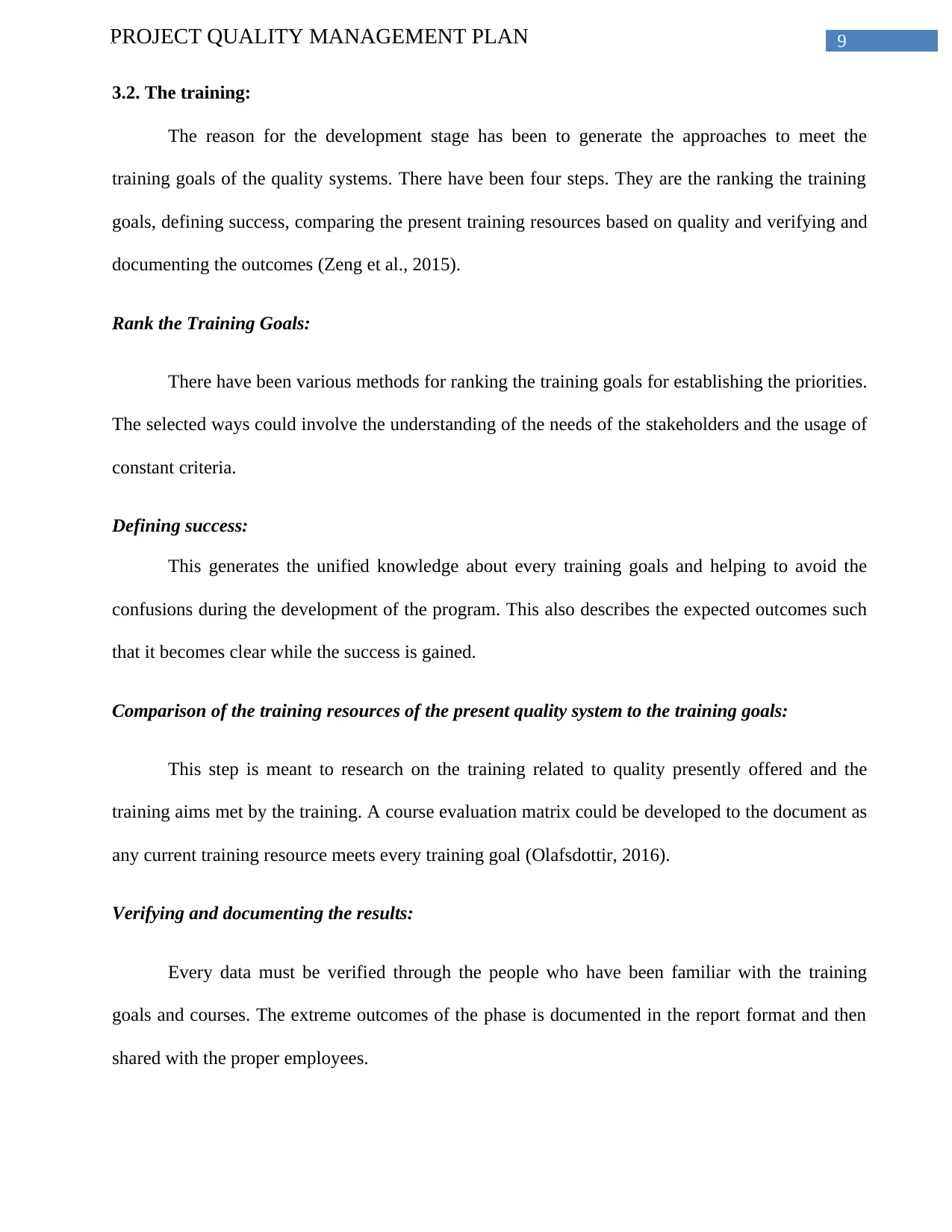
9PROJECT QUALITY MANAGEMENT PLAN
3.2. The training:
The reason for the development stage has been to generate the approaches to meet the
training goals of the quality systems. There have been four steps. They are the ranking the training
goals, defining success, comparing the present training resources based on quality and verifying and
documenting the outcomes (Zeng et al., 2015).
Rank the Training Goals:
There have been various methods for ranking the training goals for establishing the priorities.
The selected ways could involve the understanding of the needs of the stakeholders and the usage of
constant criteria.
Defining success:
This generates the unified knowledge about every training goals and helping to avoid the
confusions during the development of the program. This also describes the expected outcomes such
that it becomes clear while the success is gained.
Comparison of the training resources of the present quality system to the training goals:
This step is meant to research on the training related to quality presently offered and the
training aims met by the training. A course evaluation matrix could be developed to the document as
any current training resource meets every training goal (Olafsdottir, 2016).
Verifying and documenting the results:
Every data must be verified through the people who have been familiar with the training
goals and courses. The extreme outcomes of the phase is documented in the report format and then
shared with the proper employees.
3.2. The training:
The reason for the development stage has been to generate the approaches to meet the
training goals of the quality systems. There have been four steps. They are the ranking the training
goals, defining success, comparing the present training resources based on quality and verifying and
documenting the outcomes (Zeng et al., 2015).
Rank the Training Goals:
There have been various methods for ranking the training goals for establishing the priorities.
The selected ways could involve the understanding of the needs of the stakeholders and the usage of
constant criteria.
Defining success:
This generates the unified knowledge about every training goals and helping to avoid the
confusions during the development of the program. This also describes the expected outcomes such
that it becomes clear while the success is gained.
Comparison of the training resources of the present quality system to the training goals:
This step is meant to research on the training related to quality presently offered and the
training aims met by the training. A course evaluation matrix could be developed to the document as
any current training resource meets every training goal (Olafsdottir, 2016).
Verifying and documenting the results:
Every data must be verified through the people who have been familiar with the training
goals and courses. The extreme outcomes of the phase is documented in the report format and then
shared with the proper employees.
Paraphrase This Document
Need a fresh take? Get an instant paraphrase of this document with our AI Paraphraser
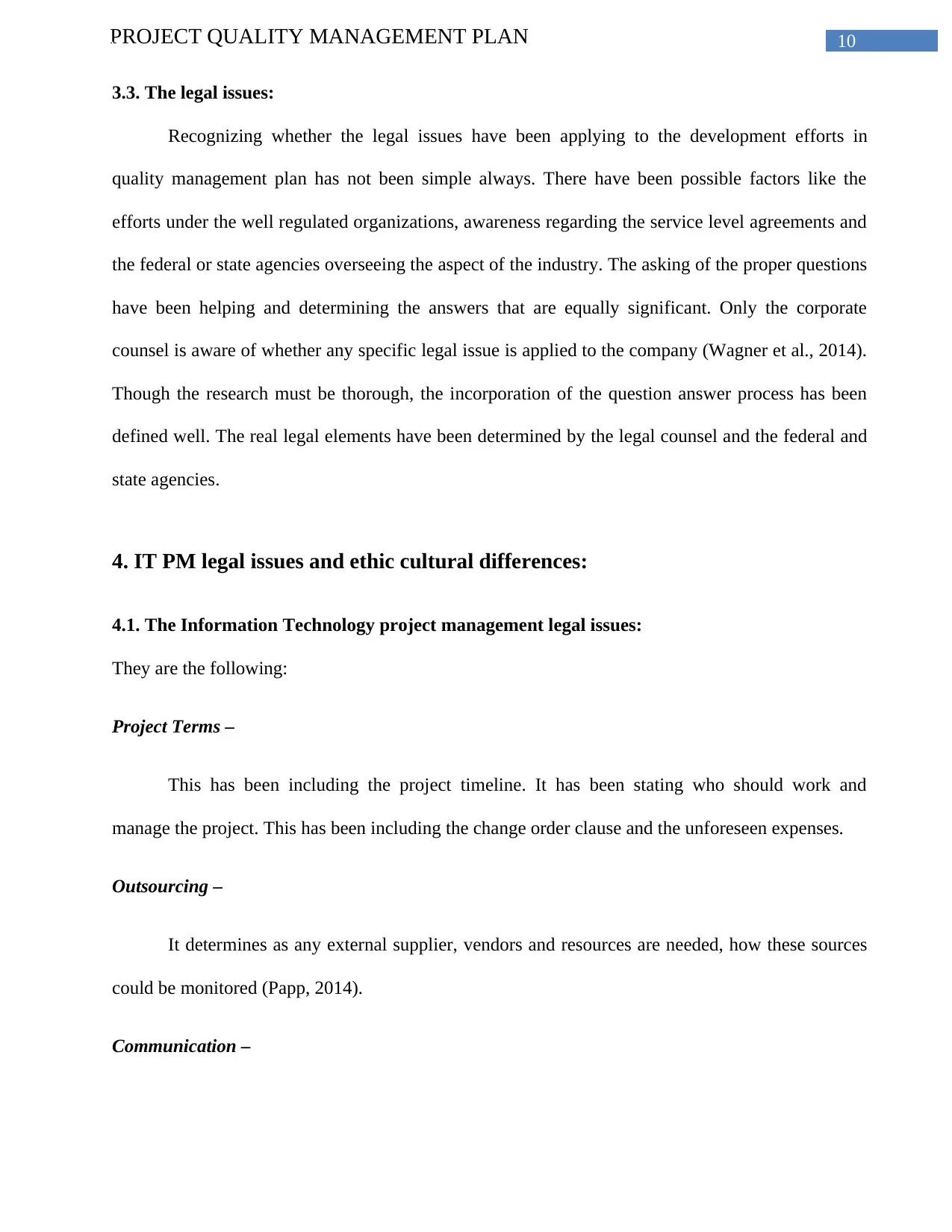
10PROJECT QUALITY MANAGEMENT PLAN
3.3. The legal issues:
Recognizing whether the legal issues have been applying to the development efforts in
quality management plan has not been simple always. There have been possible factors like the
efforts under the well regulated organizations, awareness regarding the service level agreements and
the federal or state agencies overseeing the aspect of the industry. The asking of the proper questions
have been helping and determining the answers that are equally significant. Only the corporate
counsel is aware of whether any specific legal issue is applied to the company (Wagner et al., 2014).
Though the research must be thorough, the incorporation of the question answer process has been
defined well. The real legal elements have been determined by the legal counsel and the federal and
state agencies.
4. IT PM legal issues and ethic cultural differences:
4.1. The Information Technology project management legal issues:
They are the following:
Project Terms –
This has been including the project timeline. It has been stating who should work and
manage the project. This has been including the change order clause and the unforeseen expenses.
Outsourcing –
It determines as any external supplier, vendors and resources are needed, how these sources
could be monitored (Papp, 2014).
Communication –
3.3. The legal issues:
Recognizing whether the legal issues have been applying to the development efforts in
quality management plan has not been simple always. There have been possible factors like the
efforts under the well regulated organizations, awareness regarding the service level agreements and
the federal or state agencies overseeing the aspect of the industry. The asking of the proper questions
have been helping and determining the answers that are equally significant. Only the corporate
counsel is aware of whether any specific legal issue is applied to the company (Wagner et al., 2014).
Though the research must be thorough, the incorporation of the question answer process has been
defined well. The real legal elements have been determined by the legal counsel and the federal and
state agencies.
4. IT PM legal issues and ethic cultural differences:
4.1. The Information Technology project management legal issues:
They are the following:
Project Terms –
This has been including the project timeline. It has been stating who should work and
manage the project. This has been including the change order clause and the unforeseen expenses.
Outsourcing –
It determines as any external supplier, vendors and resources are needed, how these sources
could be monitored (Papp, 2014).
Communication –
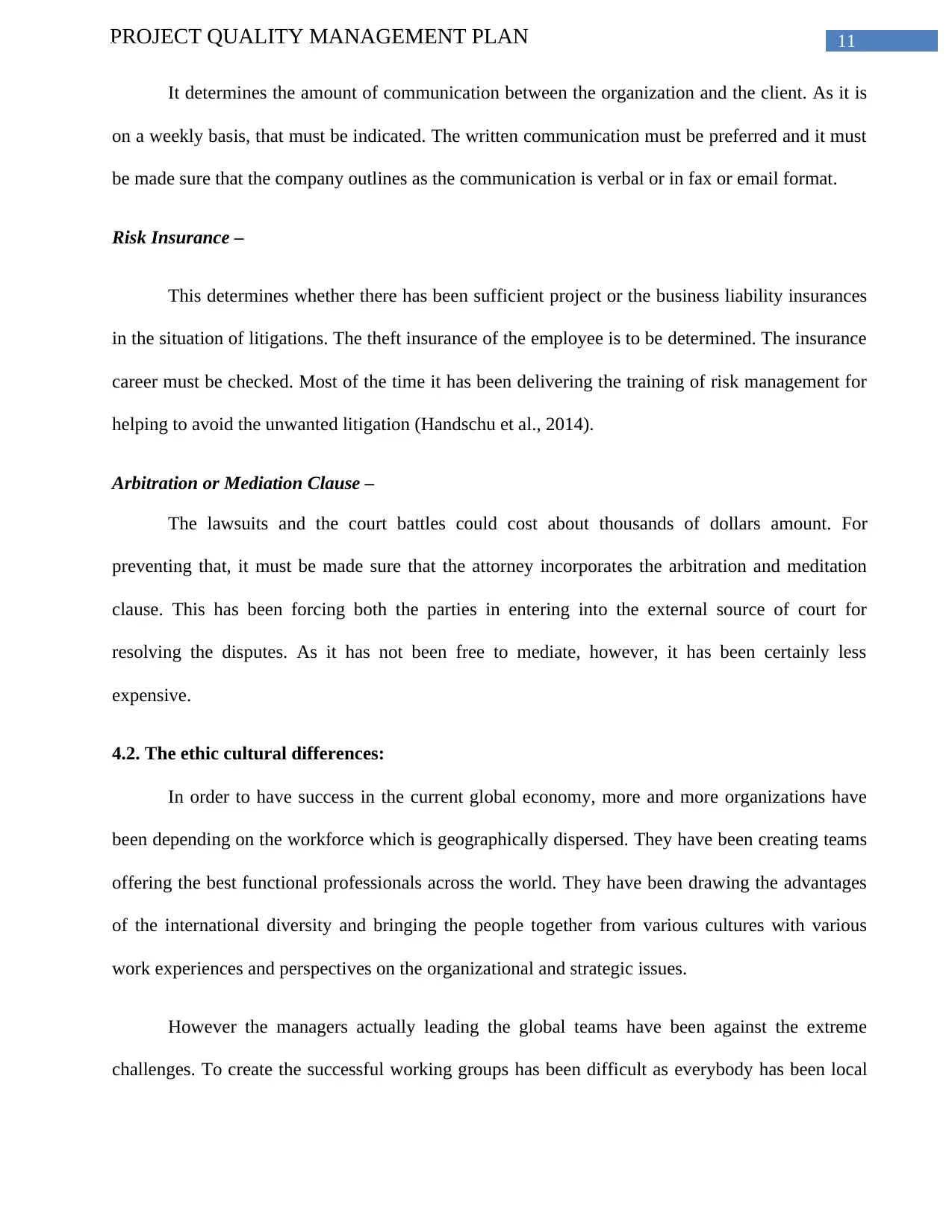
11PROJECT QUALITY MANAGEMENT PLAN
It determines the amount of communication between the organization and the client. As it is
on a weekly basis, that must be indicated. The written communication must be preferred and it must
be made sure that the company outlines as the communication is verbal or in fax or email format.
Risk Insurance –
This determines whether there has been sufficient project or the business liability insurances
in the situation of litigations. The theft insurance of the employee is to be determined. The insurance
career must be checked. Most of the time it has been delivering the training of risk management for
helping to avoid the unwanted litigation (Handschu et al., 2014).
Arbitration or Mediation Clause –
The lawsuits and the court battles could cost about thousands of dollars amount. For
preventing that, it must be made sure that the attorney incorporates the arbitration and meditation
clause. This has been forcing both the parties in entering into the external source of court for
resolving the disputes. As it has not been free to mediate, however, it has been certainly less
expensive.
4.2. The ethic cultural differences:
In order to have success in the current global economy, more and more organizations have
been depending on the workforce which is geographically dispersed. They have been creating teams
offering the best functional professionals across the world. They have been drawing the advantages
of the international diversity and bringing the people together from various cultures with various
work experiences and perspectives on the organizational and strategic issues.
However the managers actually leading the global teams have been against the extreme
challenges. To create the successful working groups has been difficult as everybody has been local
It determines the amount of communication between the organization and the client. As it is
on a weekly basis, that must be indicated. The written communication must be preferred and it must
be made sure that the company outlines as the communication is verbal or in fax or email format.
Risk Insurance –
This determines whether there has been sufficient project or the business liability insurances
in the situation of litigations. The theft insurance of the employee is to be determined. The insurance
career must be checked. Most of the time it has been delivering the training of risk management for
helping to avoid the unwanted litigation (Handschu et al., 2014).
Arbitration or Mediation Clause –
The lawsuits and the court battles could cost about thousands of dollars amount. For
preventing that, it must be made sure that the attorney incorporates the arbitration and meditation
clause. This has been forcing both the parties in entering into the external source of court for
resolving the disputes. As it has not been free to mediate, however, it has been certainly less
expensive.
4.2. The ethic cultural differences:
In order to have success in the current global economy, more and more organizations have
been depending on the workforce which is geographically dispersed. They have been creating teams
offering the best functional professionals across the world. They have been drawing the advantages
of the international diversity and bringing the people together from various cultures with various
work experiences and perspectives on the organizational and strategic issues.
However the managers actually leading the global teams have been against the extreme
challenges. To create the successful working groups has been difficult as everybody has been local
⊘ This is a preview!⊘
Do you want full access?
Subscribe today to unlock all pages.

Trusted by 1+ million students worldwide
1 out of 16
Related Documents
Your All-in-One AI-Powered Toolkit for Academic Success.
+13062052269
info@desklib.com
Available 24*7 on WhatsApp / Email
![[object Object]](/_next/static/media/star-bottom.7253800d.svg)
Unlock your academic potential
Copyright © 2020–2025 A2Z Services. All Rights Reserved. Developed and managed by ZUCOL.




